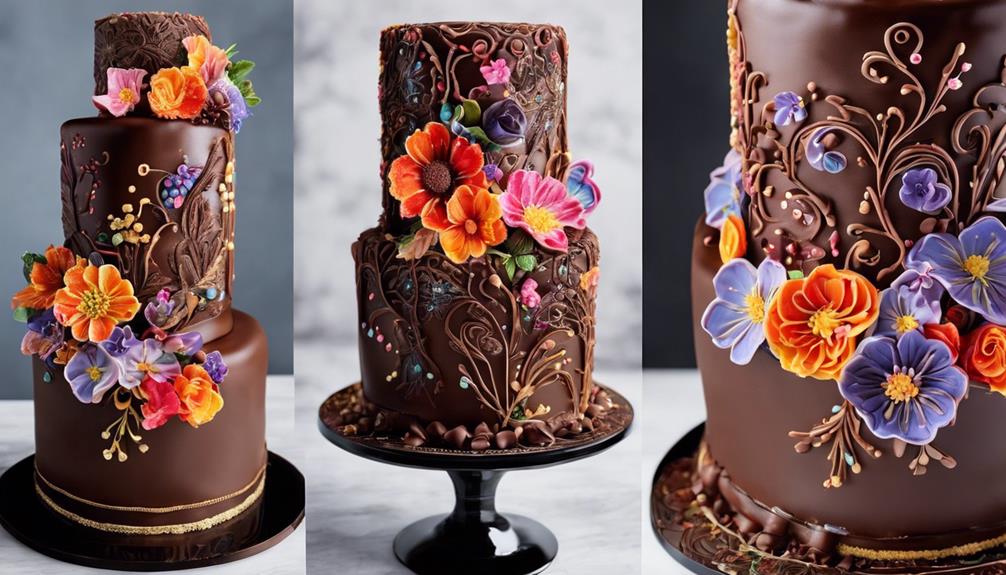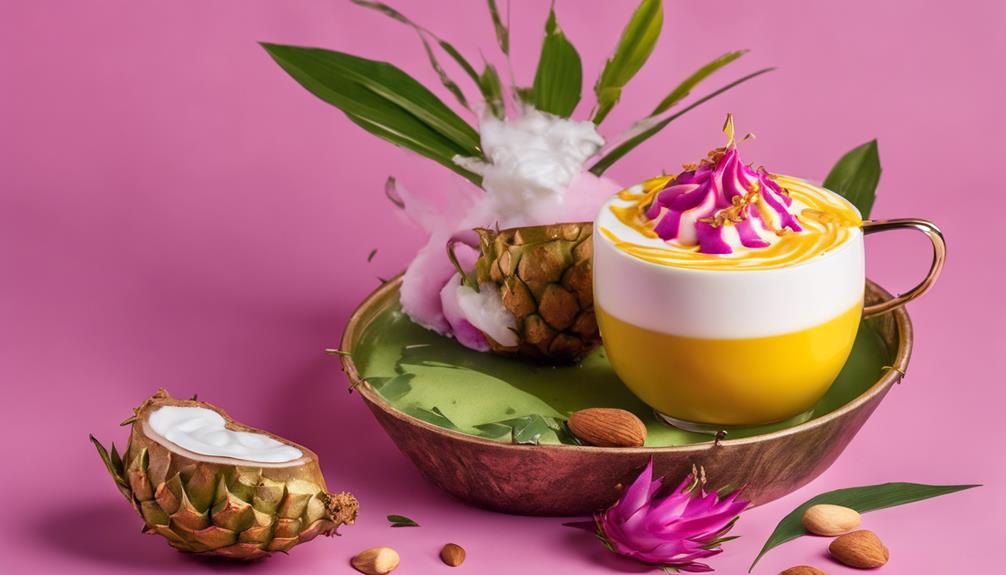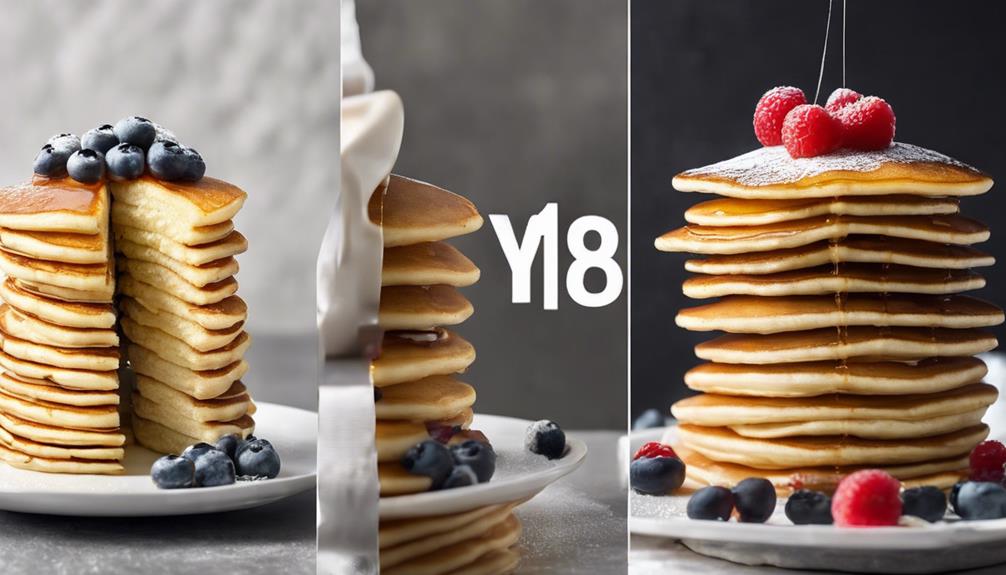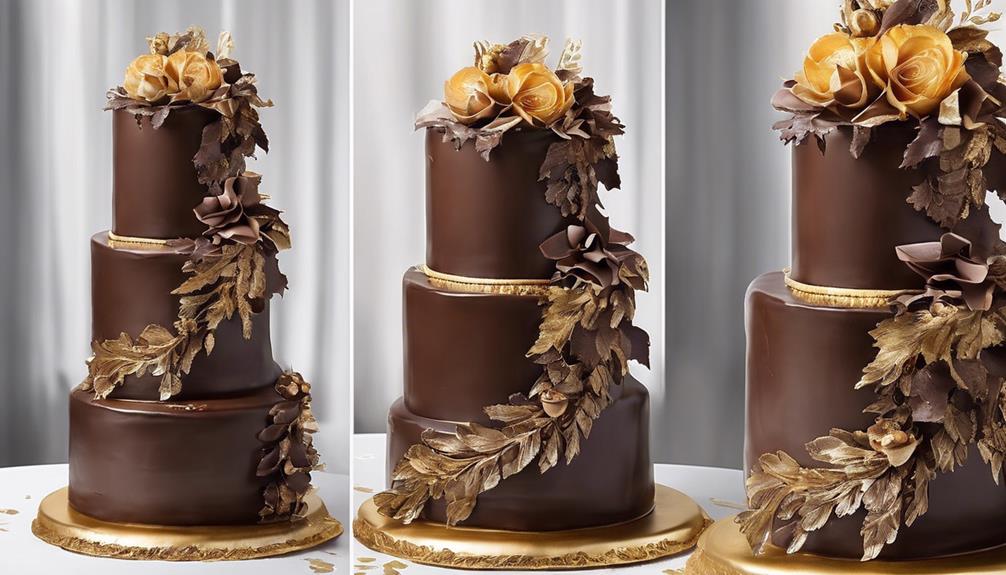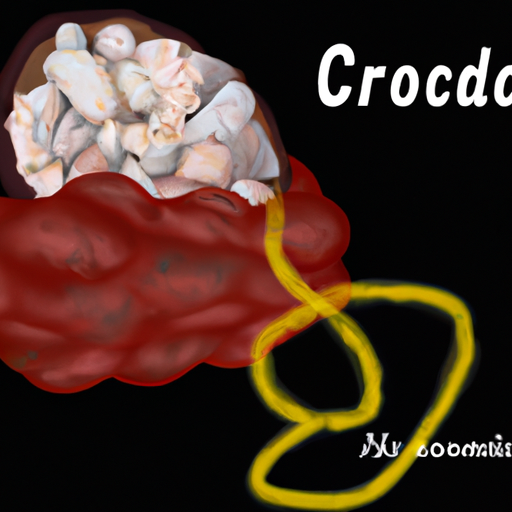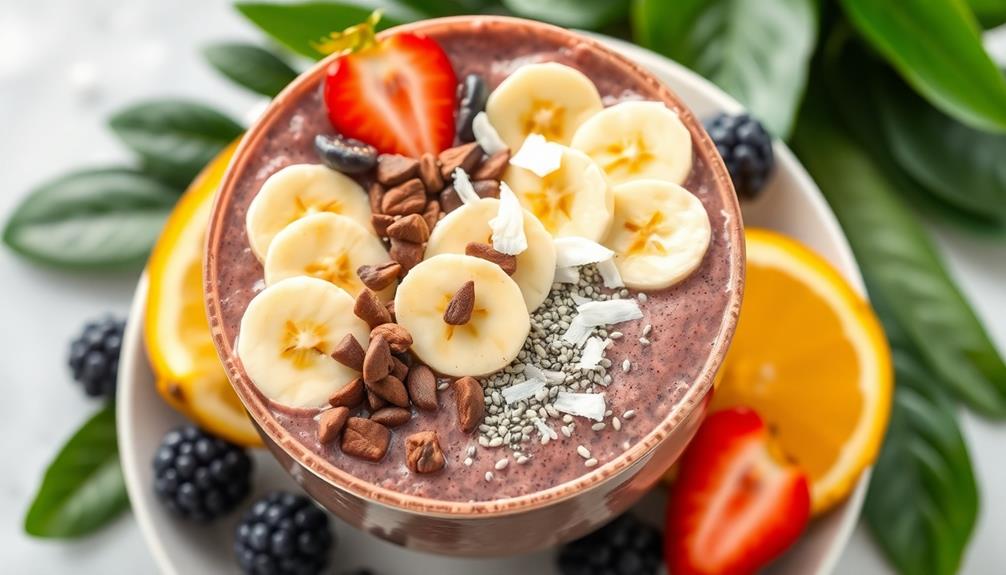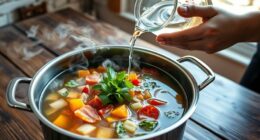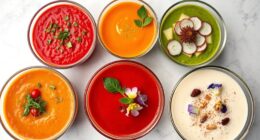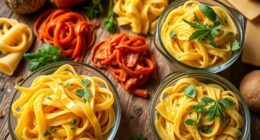For the best chocolate cake decoration, begin by using high-quality cocoa powder and making sure your eggs and milk are at room temperature. Accurate measurement of ingredients and selecting the appropriate pans are crucial. Even out your cake layers for balance, spread frosting evenly with an offset spatula, and layer a crumb coat before final frosting. Try out various piping methods and adornments such as fresh fruit or edible flowers.
Ganache should be practiced for ideal consistency, especially white chocolate ganache, where careful cream and temperature control are essential. Utilize tools like offset spatulas, piping bags, and turntables for intricate designs. Master these techniques and flavor combinations to elevate your chocolate cake presentation, with further details awaiting exploration.
Key Takeaways
- Experiment with ganache consistencies and flavors for unique decorations.
- Use piping techniques and tools for intricate designs.
- Personalize cake decorations for a memorable presentation.
- Master cake leveling and frosting for professional results.
- Combine different chocolate types and extracts for enhanced flavors.
Essential Chocolate Cake Ingredients
When baking a delicious chocolate cake, I rely on essential ingredients that form the foundation of its rich flavor and moist texture. Chocolate is the star of the show, and using quality cocoa powder is critical for achieving that deep, decadent taste. Room temperature eggs are a must as they blend seamlessly into the batter, guaranteeing a smooth and consistent mixture. Whole milk adds a creamy richness that enhances both the texture and taste of the cake. Additionally, incorporating leavening agents like baking powder and baking soda is necessary for helping the cake rise and maintain its structure.
Each ingredient plays an important role in creating the perfect chocolate cake. From the richness of cocoa powder to the creaminess of milk, every component contributes to the overall decadence of the final product. So, the next time you start on baking a chocolate cake, remember to pay attention to these key ingredients to ensure a delectable outcome.
Baking the Perfect Chocolate Cake
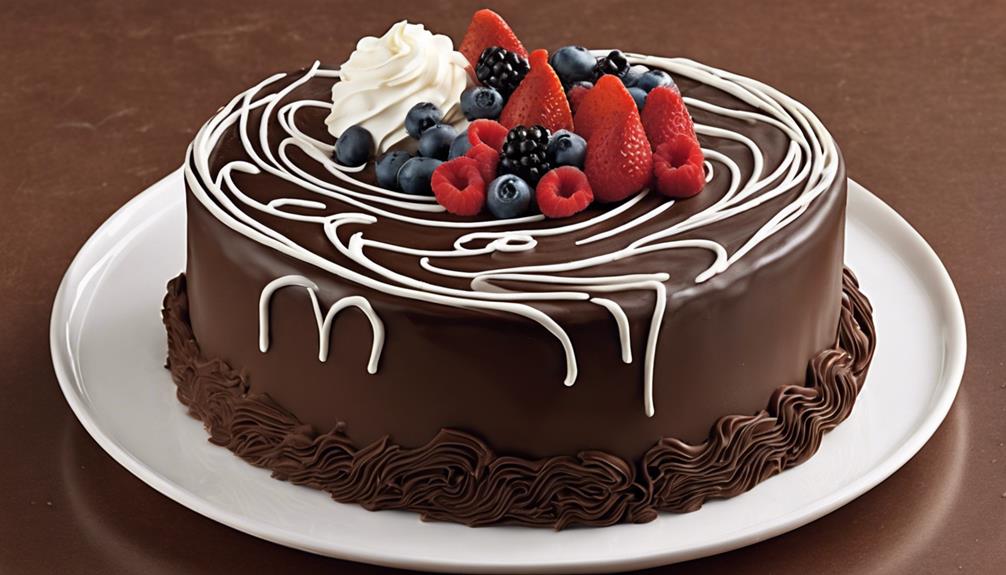
For a perfect chocolate cake, precise ingredient measurement is essential for impeccable results. Ensuring that your chocolate cake layers turn out moist and flavorful begins with gathering the right ingredients. It's vital to make sure all your ingredients are at room temperature before you start. This helps the cake batter come together smoothly, resulting in a velvety texture.
When preparing your pans, make sure to use the appropriate size and type for even baking. Following baking instructions carefully is key to achieving that rich chocolatey taste you crave. Remember not to overmix the batter to prevent a tough and dry cake. By paying attention to these details, you'll be well on your way to baking the perfect chocolate cake that will impress your friends and family.
Leveling Your Cake Layers
To achieve a stable base for decorating, it's crucial to level your cake layers meticulously. Here are some tips to help you achieve a perfectly level cake for a polished finish:
- Leveling cake layers: After your cake layers have cooled, use a serrated knife to trim off any uneven parts gently. This step guarantees that your cake will have a flat surface for decorating.
- Trimming uneven parts: Pay close attention to any domed areas on your cake layers. Evenly trim these parts to create a level surface for stacking your layers.
- Cake leveler tool: Consider using a cake leveler tool for added precision. This tool allows you to adjust the height and ensures that each layer is perfectly even.
- Stable base for decoration: A level cake provides a stable base for frosting application. With an even surface, you can achieve a smooth and flawless finish, enhancing the overall appearance of your cake.
Frosting Your Cake
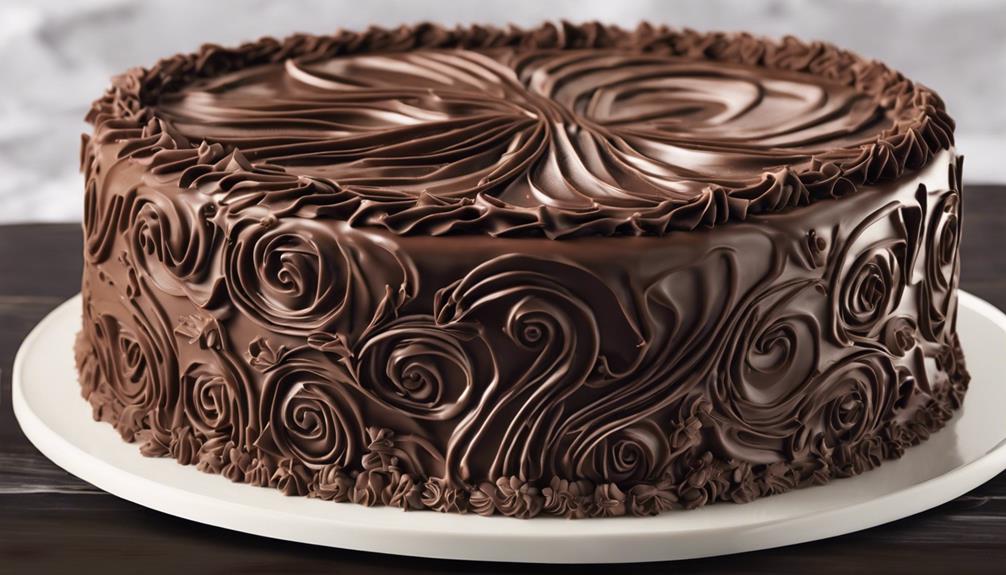
Spread the frosting evenly using an offset spatula to cover the entire surface of the cake. This step is vital in cake decorating as it guarantees a smooth and polished finish.
The consistency of the frosting is key; it should be spreadable but not too runny. Before applying the final layer of frosting, consider using a crumb coat. A crumb coat is a thin layer of frosting that seals in any loose crumbs, providing a clean base for the final frosting layer.
This technique is commonly used by professionals to achieve a flawless look. Remember, presentation is key in cake decorating. By evenly frosting your cake, you elevate its appearance to a professional level, making it visually appealing.
Mastering the art of frosting with an offset spatula and achieving the right consistency will enhance your cake decorating skills and ensure a beautiful presentation.
Adding Decorative Elements
Using fresh fruit, chocolate shavings, and edible flowers can elevate the visual appeal of your chocolate cake decorations. When layering these elements onto your moist chocolate cake, consider the following:
- Fresh Fruit or Berries: Add a burst of color and freshness to your cake, creating a vibrant and inviting look.
- Chocolate Shavings: These provide both texture and elegance to your cake, making it visually appealing and sophisticated.
- Edible Flowers: Delicate flowers like pansies or violets can bring a touch of beauty and uniqueness to your cake, perfect for special occasions.
- Personalizing Your Decorations: Make your cake more memorable by personalizing it with decorations that suit the theme or event. Whether it's a Chocolate Drip design, Buttercream Frosting patterns, or a combination of different elements, customizing your cake will make it stand out and feel special.
Enjoy decorating your cake and let your creativity shine through!
Piping Techniques for Cake Decor
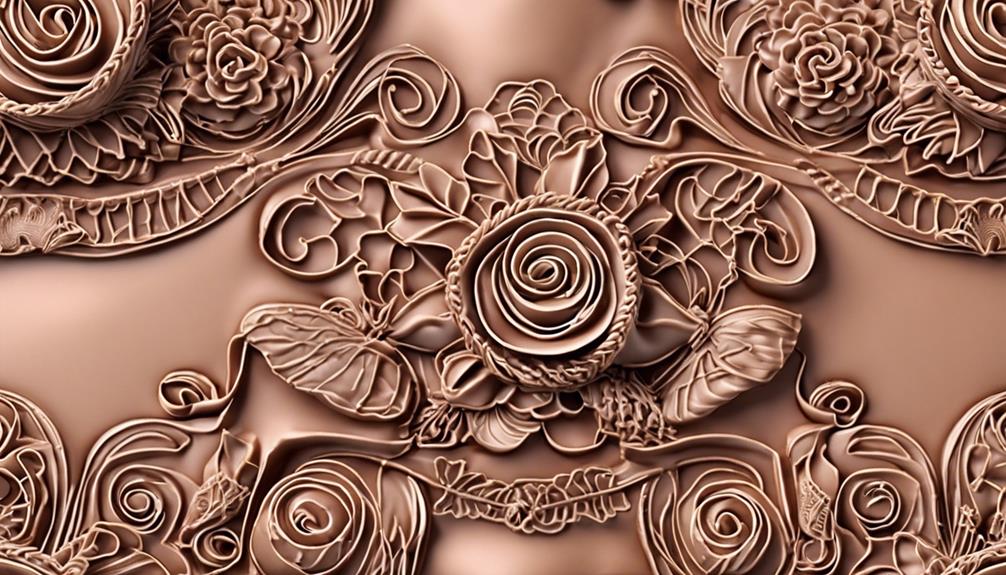
I love experimenting with different piping techniques to create stunning designs on cakes. Piping techniques involve using piping bags and various tips to create intricate designs like rosettes, borders, or writing messages on cakes.
Different tips such as star, round, or specialty tips can be utilized for specific patterns and textures, adding a professional touch to your cake decor. To master piping, it's crucial to practice on parchment paper before decorating the cake to perfect your technique. This practice allows you to get comfortable with the pressure and angle needed for different designs.
Rosettes, borders, and other decorative elements can be easily achieved with practice and the right tips. Piping not only enhances the visual appeal of your cake but also allows for creative freedom in design.
Tools for Decorating a Drip Cake
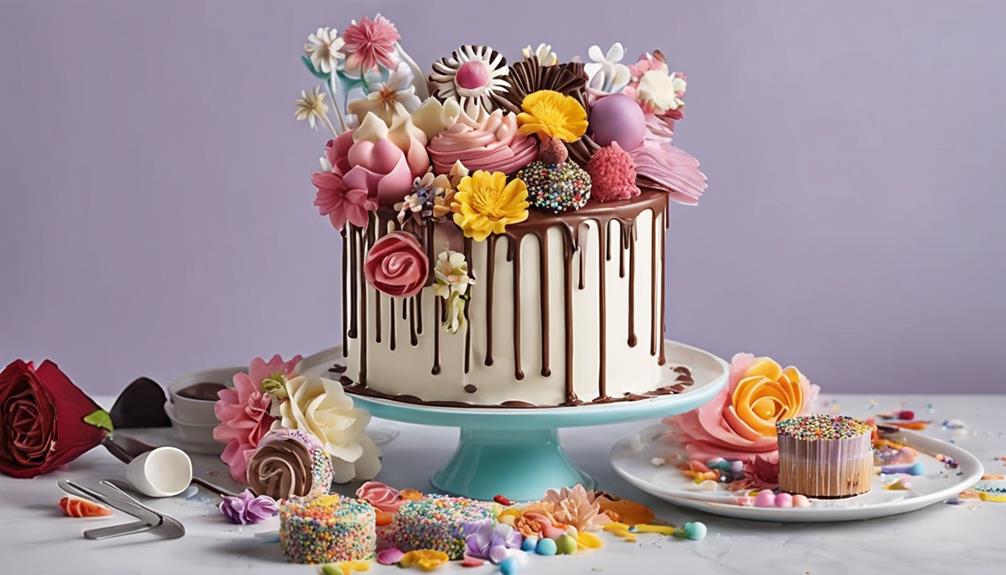
A turntable is a convenient tool that facilitates easy access to all sides of the cake for smooth decorating. When decorating a drip cake, having the right tools can make all the difference. Here are some essential items you'll need:
- Piping Bags: These are perfect for adding intricate designs and writing on your cake with precision, especially when working with chocolate ganache.
- Offset Spatula: An offset spatula is a must-have tool for smoothing frosting and spreading ganache evenly over the cake's surface.
- Decorating Tips: With a variety of patterns and textures available, decorating tips allow you to get creative with your cake decorations.
- Stencils: Stencils provide a quick and easy way to add detailed designs to your chocolate cake, giving it a professional finish.
Chocolate Drip Cake Decorating Methods
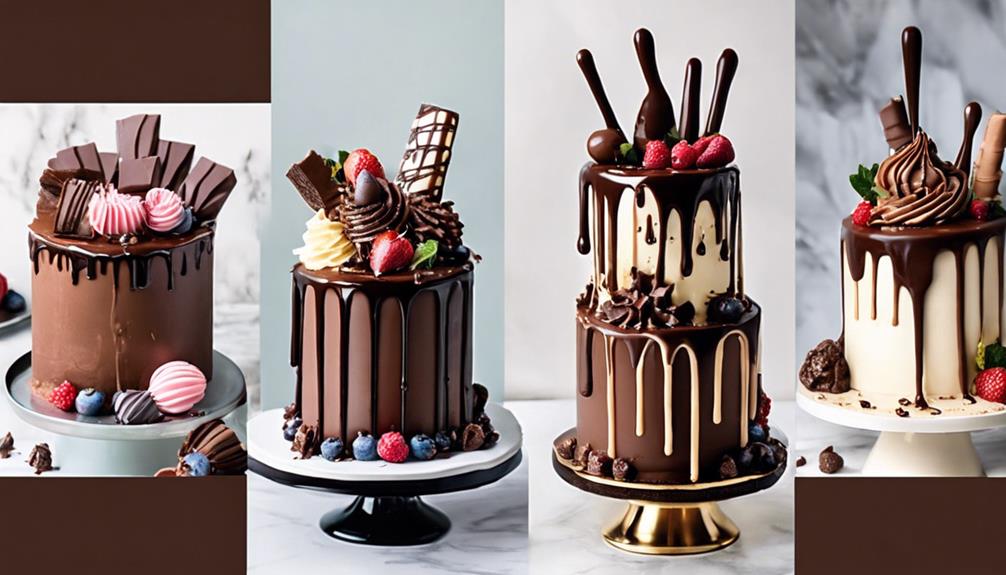
Getting that perfect drip effect on a chocolate cake involves mastering the art of applying ganache with precision and finesse. Chocolate drip cake decorating methods typically include using a squeeze bottle or spoon to carefully apply the ganache, ensuring it drips down the sides elegantly.
The temperature of the chocolate ganache plays a pivotal role in determining the thickness of the drips – warmer ganache results in thinner drips, while cooler ganache creates thicker drips. Adjusting the cream in the ganache recipe is key to controlling the consistency of the drips.
Practice is essential to achieving the ideal ganache consistency for a flawless drip cake. For a unique twist, consider using white chocolate ganache for a different look and flavor in your drip cake decorations. Experiment with different techniques and ganache consistencies to find the perfect balance for your chocolate drip cake creations.
Tips for Perfect Chocolate Drip Cake
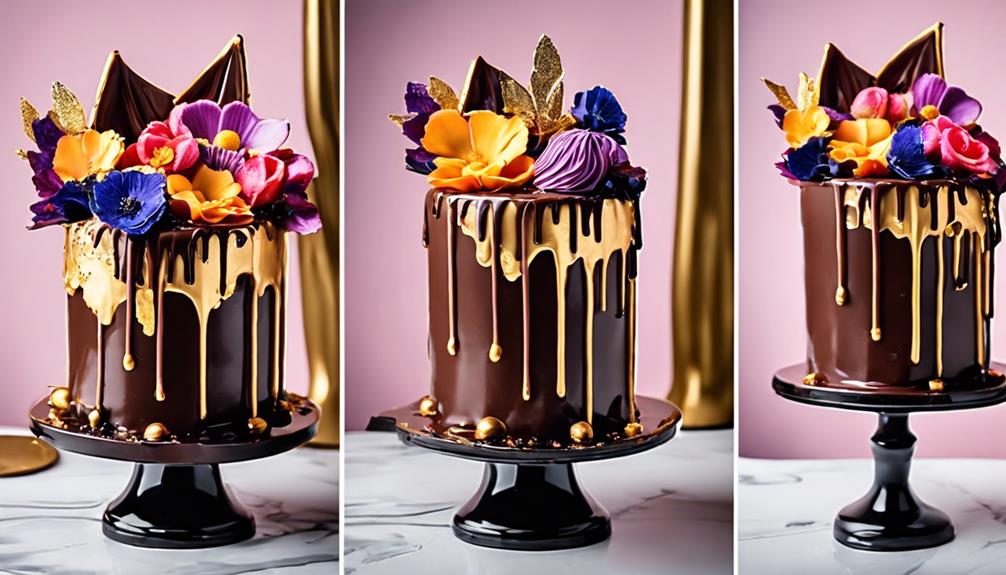
To achieve a flawless chocolate drip cake, precision in applying ganache and mastering temperature control are crucial. Here are some tips to guarantee your chocolate drip cake turns out perfectly:
- Watch the Temperatures: The temperature of your chocolate affects how thick or thin your drips will be, while the temperature of the cake influences how the chocolate behaves when dripping.
- Adjust Ganache Consistency: By tweaking the cream ratio in your ganache, you can control the thickness of the drip. Practice is key to finding the ideal consistency.
- Consider White Chocolate: When using white chocolate ganache for the drip effect, remember that it requires less cream compared to semi-sweet chocolate.
- Practice Makes Perfect: Experiment with different ganache consistencies and temperatures to master the drip technique for your chocolate cake.
Frequently Asked Questions
How to Easily Decorate a Chocolate Cake?
I start by smoothing a crumb coat on my chocolate cake. Fresh fruit, chocolate shavings, and edible flowers add charm. Piping intricate designs with various chocolates creates a masterpiece. Essential tools like piping bags and spatulas help achieve professional decorations.
Which Chocolate Is Best for Cake Decorating?
For cake decorating, dark chocolate offers rich flavors and smooth textures, ideal for intricate designs. Milk chocolate drizzles add sweetness and decorative flair. White chocolate creates contrast and creamy textures. Combining different chocolates can produce visually appealing cake decorations.
What Pairs Well With Chocolate Cake?
When it comes to chocolate cake, I love pairing it with fresh berries for a burst of fruity sweetness. Whipped cream or vanilla ice cream provide a creamy contrast, while salted caramel sauce adds a delightful sweet and salty balance.
How to Decorate the Top of a Chocolate Cake With Strawberries?
To decorate the top of a chocolate cake with strawberries, I suggest arranging whole strawberries in a circular pattern on the frosted cake. Consider slicing some strawberries for variety and adding mint leaves or edible flowers for extra flair.
Can I Use the Ultimate Guide for Chocolate Cake Decor for Easy Decorated Chocolate Cake Ideas?
Whether you’re a beginner or a pro baker, the “Ultimate Guide for Chocolate Cake Decor” has all the tips and tricks you need to create stunning decorated chocolate cake ideas. From simple designs to intricate patterns, this guide will inspire you to take your cake decorating skills to the next level.
Conclusion
To wrap up, mastering the art of chocolate cake decor is like painting a delectable masterpiece. With the right ingredients, baking techniques, and decorative skills, you can create a stunning and mouth-watering dessert that will impress all your friends and family.
So, roll up your sleeves, grab your piping bag, and get ready to unleash your creativity in the world of chocolate cake decorating. The possibilities are endless, and the results are sure to be sweet success.

